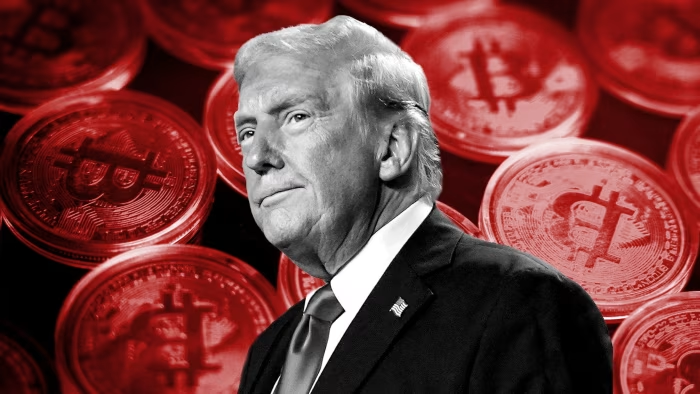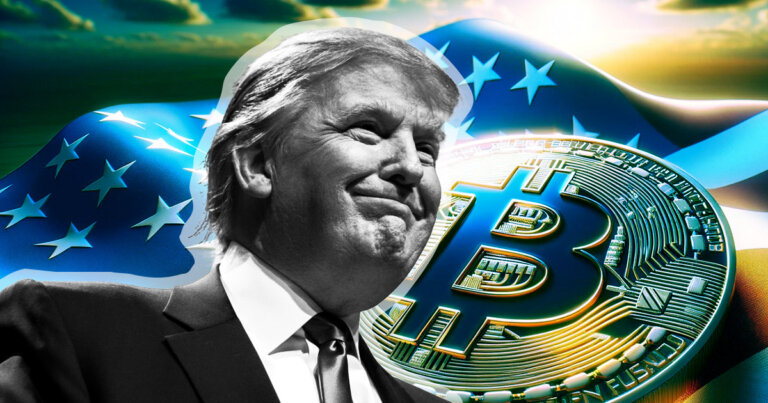Trends
Bitcoin Tops $100,000. Did Trump’s Backing Do The Trick? What Will Happen To Bitcoin In The Next Decade?
Published
10 months agoon

Bitcoin has done it—soaring past the much-anticipated $100,000 mark for the first time. As the cryptocurrency world erupts in celebration, many are asking the million-dollar question – Did Donald Trump’s pro-crypto stance fuel this surge? And where does Bitcoin go from here?
Trump’s Crypto Revolution. Game Changer or Political Play?
Former U.S. President Donald Trump has made bold promises sending ripples through the financial world. He envisions transforming the U.S. into a “Bitcoin superpower” with a national strategic Bitcoin reserve and transparent regulatory frameworks to encourage growth in the crypto industry. These pledges have invigorated investor sentiment, potentially pushing Bitcoin to its current peak of $103,844.05.
Adding fuel to the rally, Trump’s announcement to nominate Paul Atkins as the next SEC chair—a sharp contrast to the agency’s current regulation-heavy approach under Gary Gensler—signaling a seismic shift in the U.S. crypto market. Atkins, known for his market-friendly policies, is expected to bring an environment where Bitcoin and other digital assets can thrive.
The Institutional Push
It’s not just politics at play. Institutional adoption is accelerating at a breakneck pace. In 2024, leading financial giants like BlackRock, Fidelity, and Invesco rolled out the first spot Bitcoin ETFs, marking a watershed moment akin to Bitcoin’s “IPO.” The increasing institutional appetite has strengthened Bitcoin’s credibility, driving prices higher. Even Charles Schwab is gearing up for spot crypto trading, signaling mainstream acceptance is on the horizon.
Federal Reserve Chair Jerome Powell’s comments further show Bitcoin’s evolving role. Powell likened Bitcoin to gold, not as a currency but as a digital alternative for wealth preservation. While skepticism lingers around Bitcoin’s everyday utility, the comparison to gold is indicative of its emerging status as a digital store of value.

The Road Ahead. Boom, Bust, or Something New?
Mike Novogratz, CEO of Galaxy Digital, summed it up best: “We’re witnessing a paradigm shift.” His optimism is shared by many, but with caution. The crypto market is notoriously volatile, and while the next decade could see Bitcoin integrate further into the global financial system, challenges remain. Regulatory clarity, technological advancements, and market sentiment will all play critical roles.
Further, Trump’s return to the White House could accelerate crypto adoption in the U.S., prompting other nations to follow suit. Proposals like eliminating taxes on crypto transactions and supporting crypto IPOs could make the U.S. a crypto-friendly powerhouse.
When Bitcoin was launched in 2009, it aimed to revolutionize how people control their money—bypassing banks and governments, putting financial power back into individuals’ hands. Yet, despite early hopes, Bitcoin’s journey has been anything but smooth. The first decade saw scandal, volatility, and skepticism. Its second decade hasn’t been much different, but recent developments suggest Bitcoin might finally be stepping into the mainstream spotlight.
Yet, the excitement comes with a word of caution. While Trump’s endorsement may spark short-term gains, critics warn that Bitcoin remains susceptible to the infamous “bubble” phenomenon. Skeptics point out that despite regulatory advances, Bitcoin’s fundamental volatility and lack of traditional backing make it a risky long-term bet.
The SEC’s Role in Bitcoin’s Evolution
Even before Trump’s announcements, the U.S. Securities and Exchange Commission (SEC) played a pivotal role in legitimizing Bitcoin. Its approval of 11 Bitcoin ETFs has opened the doors for cautious investors who were once wary of diving into the complexities of cryptocurrency trading. ETFs simplify access to Bitcoin, allowing traditional investors to participate without dealing with wallets, keys, or exchanges.
Market analysts have hailed this move as a watershed moment, likening it to the early days of internet stocks. However, regulatory uncertainty lingers globally, and for Bitcoin to truly thrive, broader international cooperation and acceptance are essential. Countries outside the U.S. must follow suit with clear crypto regulations to ensure that Bitcoin’s growth is sustainable and widespread.
The Rise of Cryptocurrencies
Bitcoin’s roots trace back to the aftermath of the 2008 financial crisis, a period of deep distrust in traditional financial institutions. Introduced two months after the collapse of Lehman Brothers, Bitcoin offered an alternative—decentralized, transparent, and independent of central banks. This promise of a new financial order is what drove early adoption, but it’s also what fuels skepticism today.
Despite doubts, Bitcoin has seen remarkable growth since 2009. Its underlying technology, blockchain, has proven resilient, and digital assets have become an increasingly significant part of global financial systems. From niche beginnings to institutional portfolios, cryptocurrencies are no longer a fringe movement but a legitimate financial force.

The Indian Crossroads
When it comes to India, its relationship with cryptocurrencies has been anything but straightforward. While the global crypto bull run enticed millions of Indian investors, the government’s heavy-handed tax policies have thrown a wrench into the works. After a stellar 2021 for crypto in India, the following years saw the sector falter, particularly in 2023, when a prolonged bear market and burdensome taxation stifled growth.
Tax Woes
In 2022, India introduced a 30% tax on crypto gains along with a 1% TDS (tax deducted at source) on every transaction. This move drastically affected trading volumes, with Indian exchanges seeing a staggering 95% decline. The fallout was severe, as millions of traders moved to offshore platforms to sidestep the high tax burden.
A report by the Esya Centre showed the extent of the damage: an estimated 3-5 million Indian traders migrated to foreign exchanges, costing domestic platforms around $3.8 billion in trading volume. While there has been a recent uptick in activity, with volumes quadrupling, Indian exchanges face an uphill battle in regaining their footing and proving their valuations.
Further, in a bold move earlier this year, India blocked access to foreign crypto exchanges like Binance, Kucoin, and OKX, citing money laundering concerns flagged by the Financial Intelligence Unit (FIU). While this decision disrupted the crypto ecosystem, it also gave domestic platforms a temporary boost by redirecting local traders back to homegrown exchanges. Yet, questions remain about whether such protectionist measures can truly foster long-term growth or merely serve as a short-term fix.
Despite the challenges, the allure of crypto remains strong in India. The country’s thriving startup ecosystem, with nearly 900 crypto-focused ventures, stands ready to capitalize on the sector’s potential. However, regulatory uncertainty continues to push talent and businesses overseas, contributing to a significant brain drain.
Experts believe that 2024 could be a pivotal year. The G20 deadline for crypto regulation looms large, and there’s hope that India will finally establish a clear regulatory framework. Such clarity could resolve ongoing issues like unstable banking relationships and complex tax structures, unlocking the vast potential of the crypto market.

What Will Happen To Bitcoin In The Coming Decade?
While Bitcoin’s price and popularity grab headlines, the real story lies in its underlying technology: blockchain. Over the next decade, the success of Bitcoin will hinge on how well it can address three key issues—decentralization, scalability, and security. These challenges must be resolved if Bitcoin is to evolve beyond being a speculative asset and become a mainstream financial tool.
Adoption Trends. A Global Snapshot
Despite its hurdles, Bitcoin adoption has steadily grown, especially in economically challenged regions. According to Chainalysis, the Central, Southern Asia, and Oceania regions lead in cryptocurrency adoption, primarily driven by Bitcoin. However, in 2024, adoption in high-income countries has picked up, thanks in part to regulatory approvals for Bitcoin investment instruments in the U.S.
This trend is the key. If adoption continues across diverse economies, Bitcoin could become more than just a niche investment. But the question is – Will adoption accelerate, or will challenges like regulation and volatility slow it down?
The Centralization Dilemma. Bitcoin the Cryptocurrency
Bitcoin was envisioned as a decentralized currency, free from the control of any single entity. Yet, the reality in 2024 suggests otherwise. Large institutions and businesses have steadily accumulated significant Bitcoin holdings, reducing the amount in the hands of individual users. If Bitcoin continues to be seen primarily as a store of value, this centralization trend is likely to deepen as supply diminishes.
Bitcoin the Blockchain
Initially, Bitcoin’s blockchain was meant to be a public, widely distributed network. However, its rapid market value surge led to the rise of large-scale mining operations. These mining farms now dominate the network, sidelining individual miners.
As of October 2024, ten mining pools control over 93% of Bitcoin’s total hash rate, with just three pools accounting for more than 82%. This concentration of power raises concerns about the blockchain’s future. Although it remains a distributed ledger, the potential for a few large entities to exert significant influence is undeniable.

Decentralization, Scalability, and Security
For Bitcoin to thrive over the next decade, it must overcome three fundamental challenges:
- Decentralization – Solutions that democratize mining and ownership are crucial. Initiatives like decentralized mining protocols or broader coin distribution strategies could help rebalance control.
- Scalability – As demand grows, Bitcoin needs to process more transactions faster and at lower costs. Layer 2 solutions like the Lightning Network show promise but require broader adoption.
- Security – Ensuring network integrity in the face of concentrated mining power is critical. Strengthening security protocols and encouraging diversification in mining operations will be essential.
Will Bitcoin Lead the Financial Revolution?
As Bitcoin enters uncharted territory, the possibilities seem limitless. Could it become a cornerstone of national reserves? Will it replace gold as the ultimate store of value? Or will regulatory hurdles slow its momentum?
For now, the crypto community is riding high, and the next decade for Bitcoin promises to be anything but dull.

You may like
-


Taiwan’s ‘Historic’ TSMC Deal, A Win Or The End Of Its ‘Silicon Shield’ As China Threatens? A Jittery Taiwan Watches Trump’s Moves On Ukraine, Wondering, Could We Be Next?
-


America And China’s Thirst For Gold In 2025 Is Draining Other Countries’ Reserves; Here’s Why?
-


Germany’s Friedrich Merz’s Big Balancing Act—Trump, Borders & Europe’s Future. Can He Deliver?
-


United Kingdom To Unleash Its ‘Harshest’ Sanctions On Russia Yet—But Will They Bite? How Trouble Is Brewing For Keir Starmer At Home. Shamed For Volunteering British Troops In Ukraine
-


How It’s Not Trump But Vladimir Putin That Europe Is Stinging From: Trump’s U-Turn On Europe, Russia’s Strong Supply Chain—A Formidable Opponent!
-


Is Ukraine Now Stuck In The US-Russia Ecosystem? Could Zelensky Have Made A Deal To Stop The War, Is Trump Right?